________________
30
The Pañcarātra
[CH.
of the individual becomes merged in Brahman. The association of the conscious element with the unconscious psychosis, which has evolved from prakṛti, is not due to a false imaging of the one or the other, or to an illusion, but to the operative power of the indwelling energy of God, which exists in us. The individual, called also the Atman, is the product of this forced association. When the complex element is disassociated from the psychosis and the root-instincts, it becomes merged in Brahman, of which it is a part and with which it exists in a state of unity-in-difference. The difference between this view and that of the Samkhya is that, though it admits in general the Samkhya view of evolution of the categories from prakṛti, yet it does not admit the theory of Puruşa and the transcendental illusion of Puruşa and prakṛti, which is to be found in the classical Samkhya of Isvara kṛṣṇa. There is no reference here to the teleology in prakrti which causes its evolution, or to the view that the prakrti is roused to activity by God or by Purușa. Prakṛti is supposed here to possess a natural productive power of evolving the categories from out of itself.
The Jayakhya-samhitā speaks of the devotee as a yogin and holds that there are two ways of arriving at the ultimate goal, one through absorptive trance, and the other through the practice of concentration on the mantras. In describing the process of Yoga, it holds that the yogin must be a man who has his senses within his absolute control and who is devoid of antipathy to all beings. Full of humility, he should take his seat in a lonely place and continue the practice of prāṇāvāma for the control of mind. The three processes of praṇāyāma, viz. pratyāhāra, dhyāna, and dhāraṇā, are described. Then, Yoga is stated to be of three kinds, prākṛta, pauruşa and aiśvarya, the meaning of which is not very clear. It may, however, be the meditation on prakṛti's ultimate principle, or on Puruşa, or the Yoga, which is intended for the attainment of miraculous power. Four kinds of asanas are described, namely, that of Paryamka, Kamala, Bhadra and Svastika. The Yogic posture is also described. The control of the mind, which again is regarded as the chief aim of yoga, may be of two kinds, namely, of those tendencies of mind which are due to environments and of those that are constitutional to the mind. It is by increasing the sattva quality of the mind that it can be made to fix itself upon an object. In another classification we hear of three kinds of yoga, sakala




